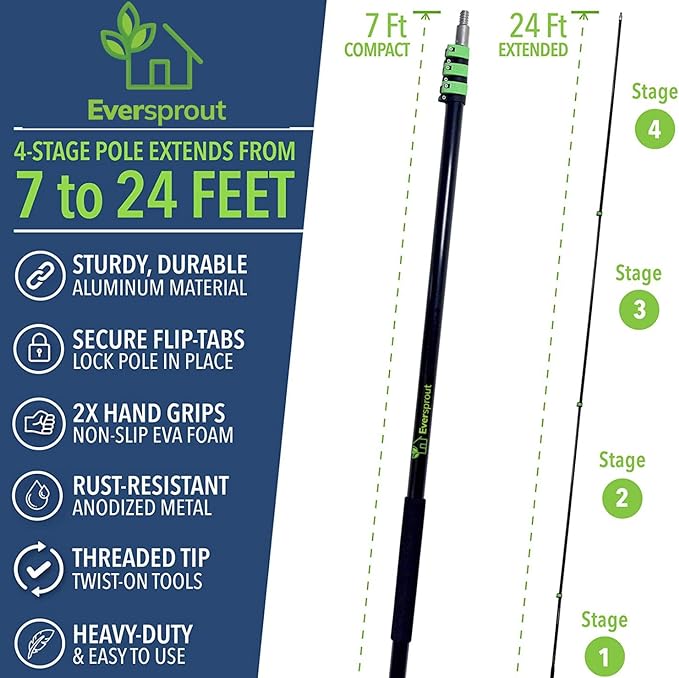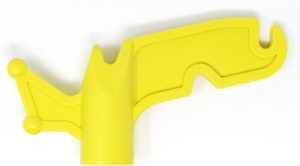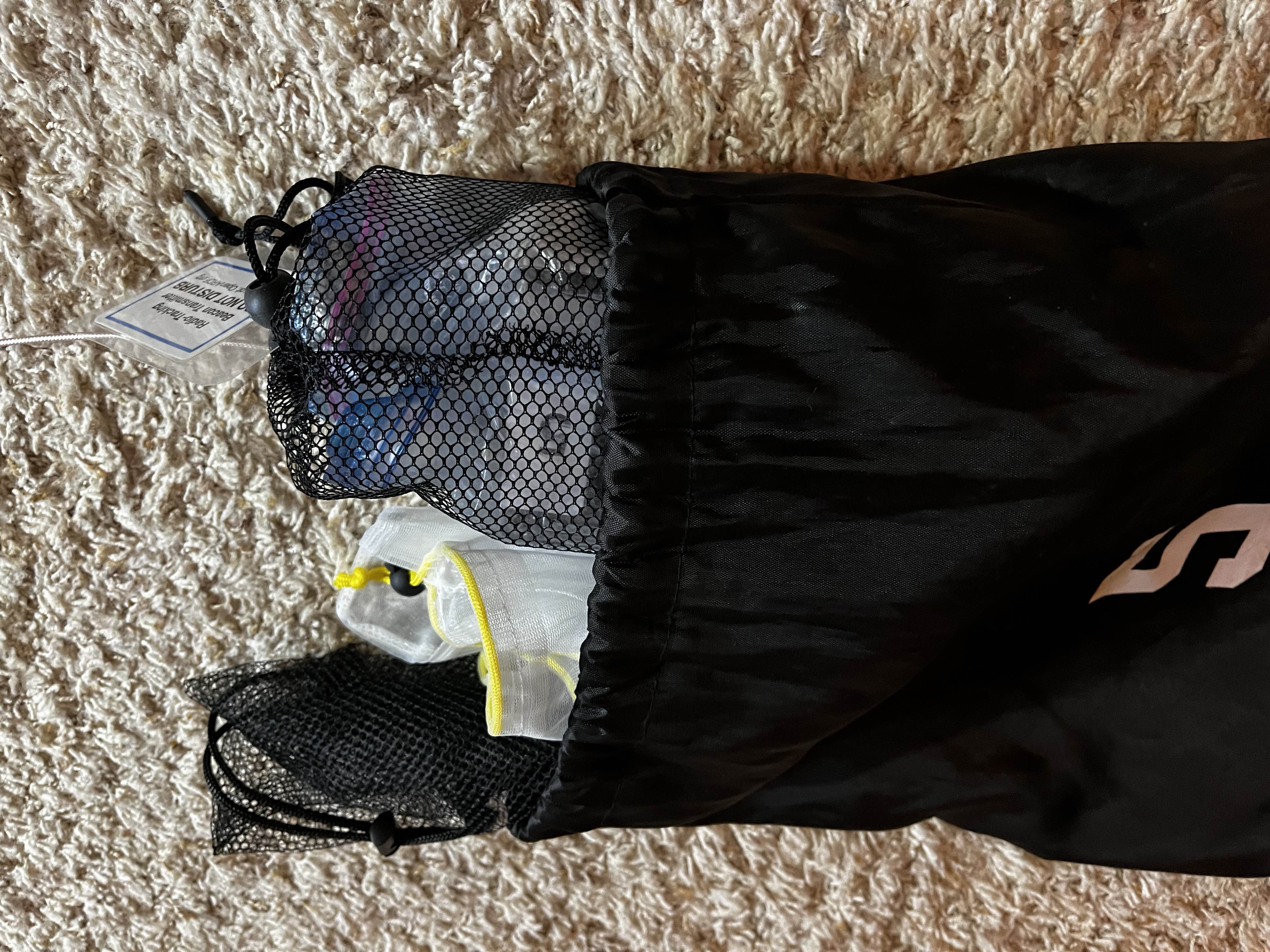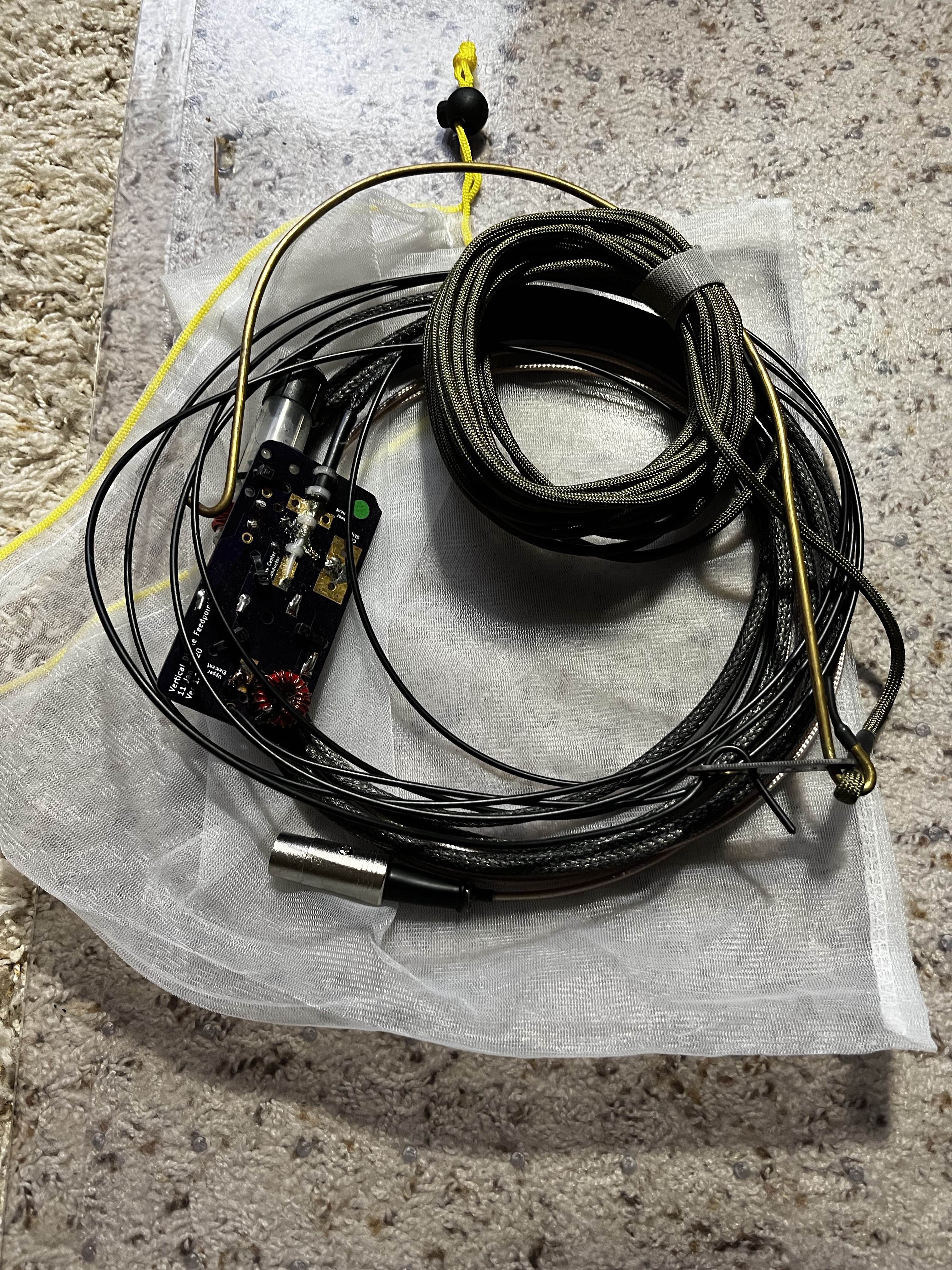Fox-in-Bag
Everything you need fits into a quick-drying nylon bag
- Flag with SI Box
- FlexFox Transmitter
- Antenna
Up to five Classic foxes can fit inside a large backpack. A large, comfortable backpack with a frame, will keep most of the weight on your hips, preserving your back. Don’t forget to take a master map (or GPS) with you so you can find the fox locations!
The only other essential tool is a telescoping pole (reaching up to 24ft / 11.3m) with a Christmas light hanger on top. The pole is used for hanging antennas onto suitable branches and makes a dandy hiking pole.

Step 1: Find a suitable tree branch
Quickly identifying a suitable branch takes practice. Such branches are common in North Carolina woods, so finding one close to the intended fox location is usually not an issue. Choosing a good candidate will make antenna deployment and collection easier.
The ideal tree branch will be 20ft to 24ft (6m to 7.3m) above the ground and easily accessible with the telescoping pole. It should be strong enough to hold the weight of the antenna without breaking. The thickness of the branch matters little since the brass hook will work with a wide range of branch sizes.
Consider where the transmitter will be placed (and concealed) at the base of the tree after the antenna is deployed. Also, identify a place to hang the orienteering flag within about 4 meters of the tree.
Step 2: Deploy the Antenna
Antennas are made of lightweight materials, making them easy to carry. But the thin wires also mean that they can be damaged if a wire is kinked and pulled tight. Kinks in the wires need to be avoided.
Stand near the tree branch targeted to hold the antenna. Clear away any loose brush or branches nearby that might snag the antenna while you deploy it.
Remove the antenna from its mesh bag. DO NOT UNROLL THE ANTENNA. Set the coiled antenna on the ground with the brass hook resting on top.
Pick up the brass hook. (The antenna wire should dangle beneath the hook, coiled loosely.) Bend the hook into a suitable question mark (?) shape if needed.
Remove the strap holding the “collection string” and give the loop of string a toss to one side. With practice, the string will unfurl without tangling. If the string is tangled, untangle it and lay it along the ground before proceeding.
Place the brass hook on the top of the telescoping pole in one of the slots of the Christmas light hanger.

Raise the hook by extending the telescoping pole upward toward the target branch. The coiled antenna should uncoil like a slinky. If the antenna snags or kinks, correct the problem before pushing the antenna any higher.
Place the hook gently over the target branch. Then, carefully extract the hanger from the hook by lowering it slightly.
You will know that the antenna is at the right height if the end of the collection string hangs 4ft to 6ft (1.2m to 2m) above the ground. The 5-pin antenna connector should reach the ground with 1ft to 4ft (30cm to 120cm) of cable laying on the ground.
You can secure the dangling collection string to a small lower branch or by running the string around the tree and connecting the velcro strap to the antenna wire.
Return the antenna’s white mesh bag to the numbered black nylon bag that held the antenna, transmitter, and flag.
Place the Transmitter
The transmitter should be placed near the base of the tree, as close to the trunk as feasible, to prevent it from getting stepped on by passing runners.
Be sure to power on the transmitter using the switch on the battery. Once powered on, you will see LEDs blinking under its clear top. (The LEDs time out after a few minutes, so don’t be concerned if the LEDs go dark shortly after powering the transmitter.)
Plug the antenna’s 5-pin connector firmly into the transmitter’s antenna jack. Slide it in completely until you can feel the plug is fully seated in the jack. The green LED should light up, indicating that the antenna has been detected. (The LEDs time out after a few minutes, so don’t be concerned if the LEDs go dark shortly after powering the transmitter.)
Place the transmitter gently inside its plastic bag, then place the black mesh bag around the outside of the plastic bag.
Place all materials, including the transmitter, inside the numbered black nylon bag that held the antenna, transmitter, and flag. The white mesh antenna bag and black mesh flag bag should also be placed in the nylon bag. That will ensure all materials are at the fox location when the equipment is collected following the event (see image below).

Once the transmitter and mesh bags are inside, cinch up the nylon bag’s top (the antenna wire running out of it), then place the bag near the base of the tree and cover it with leaves, sticks, or other natural materials you find nearby. This will make the transmitter and its antenna nearly invisible.
Hang the Flag
Hang the orienteering flag within ~4 meters of the antenna, preferably in a location that will not bring runners closer to the antenna than necessary. This will avoid having a competitor trip over the transmitter or grab the antenna wire, thinking it was a vine! (It has never happened, but you never know.)
Collection
Collecting foxes is easier than deploying them. Everything you need is located at each Fox location. The telescoping pole is not needed if you remembered to unfurl all the collection strings when you hung the antennas! Take a large empty backpack with you and a master map or a receiver if the foxes are still transmitting.
Upon reaching a fox, open its numbered black nylon bag and disconnect the antenna by pulling the antenna plug from the transmitter’s antenna jack. (Don’t pull on the antenna wire or coaxial cable.)
Grab the end of the antenna’s collection string and move to a location that provides the antenna’s hook with a clear path from its branch to the ground.
Hold the string away from your body and pull firmly on the string with a constant force. Do not jerk on the string. Increase the tension until the antenna’s brass hook deforms enough that it slips from the branch and flies to the ground. CAUTION: THE HOOK WILL COME FLYING OUT OF THE TREE LIKE A BAT OUT OF HELL – BE CAREFUL THAT NO ONE IS STANDING IN ITS TRAJECTORY! I can attest that, if care is not taken, the hook can be painful and leaves unsightly bruises. Eye protection is highly recommended.
With the antenna safely on the ground, pick up its brass hook. Feel free to bend the hook back into a question mark so it is ready to deploy the next time. Then, starting at the hook end, wind the collection string around the fingers of one hand into a small coil of string. Then, firmly attach the string to the hook using the velcro strap wrapped tight (see image below).
Holding the hook and string in one hand, and starting where the wire attaches to the hook, gently wind the antenna into a loose loop about the same diameter as the hook. Avoid kinks. If wound loosely and carefully, the antenna will be easy to deploy the next time it is used. When you reach the end (antenna plug), place the looped-up antenna into the white mesh bag, cinch it up, and put the bagged antenna into the black nylon bag.

This is how a properly coiled antenna should look. It is ready to be slipped into its mesh bag (shown underneath).
Place the orienteering flag into its mesh bag. Then place all items (transmitter, antenna, and flag) into the numbered black nylon bag. Lather, rinse and repeat until all foxes have been collected.
